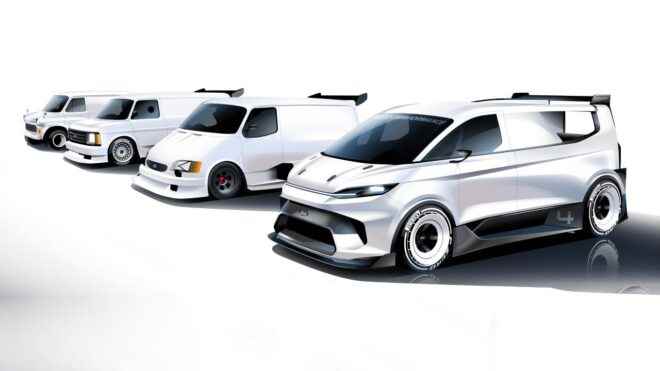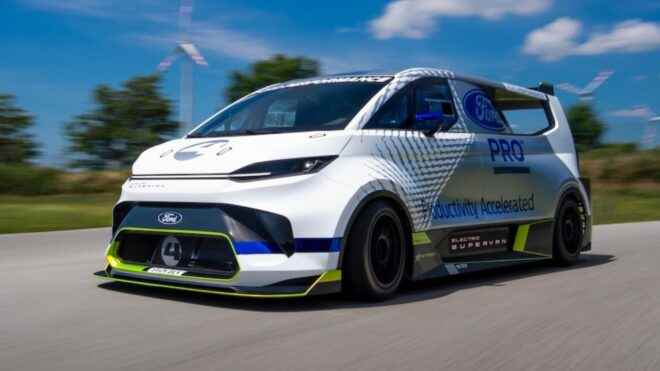Levent Tuna talked about “Electric SuperVan”, one of the most ambitious projects in Ford’s history, with its highlights.
We are witnessing more and more frequently that the electrification transition process has moved the stones for many iconic models. These moving days brought with them some happy and sometimes sad developments in the focus of farewells. Ford Transit plays the leading role in one of the good parts of the story. The Transit badge, which is produced in Turkey and exported to many important countries, also hits the road with the “e-Transit” badge due to the dynamics of the market.
As well as the commercial face of Transit, there is a “speed adventure” in itself that perhaps many people overlook. Last June, we met the new generation of the model group, which has attracted attention with special projects under the name SuperVan for a long time. SuperVan, which was built on an all-electric infrastructure for the first time, made its way into Ford history with its promised performance and power values. Turkish designer Levent Tuna’s signature under this project brings the process to a more remarkable level for us.
“SuperVan”; Attempts to fly across the galaxy with an icon
Before listening to the “SuperVan4” project from dear Levent Tuna’s own words, it is necessary to understand exactly what the SuperVan badge means. When we tinker with the dusty shelves, we see that the SuperVan adventure in Ford dates back to the early 70s. In the first project in which the boundaries were moved to a completely different dimension for Transit, whose production adventure began in the mid-60s, the engine side brings a legendary integration along with the improvements made on the chassis. We see that the SuperVan adventure was started by combining the engine of Ford GT40, which gave us unforgettable adventures in LeMans races and brought terms such as “Gurney Bubble” to history due to its design limits, with the Transit. The model, which has 400 horsepower of the V8 machine, has unimaginable limits for a commercial vehicle such as 240 km / h.
For the second SuperVan project, we see that Ford waits until the mid-80s. In this project, in which the second generation Transit is at the center, we come across a scheme in which an eight-cylinder Cosworth engine is used this time. The Mark II project also takes the limits of the previous generation one step higher, with a speed limit of 280 km/h. With the Transit’s transition to the third generation, this time in 1994, the SuperVan3 project is getting rid of its veils. The meeting of the SuperVan adventure, which has a history of 50 years in Ford, with the electric power, which is the trend of today, revealed unprecedented technical values. What made the SuperVan4 project, which was launched to the whole world last summer, extra special for us was that it bore the signature of our successful designer Levent Tuna. We talked to him about both his adventure and the electric SuperVan.
First of all, “Who is Levent Tuna?” can you answer the question?
Certainly. I was born in Eskişehir. I can say that a part of my life was spent in Bursa and a part in Istanbul. My arrival in Istanbul was when I won Mimar Sinan Fine Arts University. After my education, I started working at Ford Otosan in 2012. We worked on various projects at Otosan for about 7.5 years and worked with our teammates. I designed the “F-Vision” project, which is the last one and the most special one for me. The year 2020 was one of the most important turning points for me and I started working at Ford Cologne. I have now completed 2.5 years here. I worked on various projects here as well, but the most special one for me was the “SuperVan4 project”, which was screened at the Goodwood Festival of Speed on 23 June.

What do you think the SuperVan adventure means to Ford?
When we look at the history of the SuperVan, we see that it was designed as a racing vehicle with a GT40 engine based in the UK in 1971. Afterwards, it turned into a family, one of the sine qua non of every new generation. I think the SuperVan is a special model on the Ford roof to show that sporty driving is important for every vehicle. After the SuperVan3 was made, the company went on hold for many years. The realization of the new generation, as you can see, goes back to our era.
What were the initial stages of the project like?
For me, it was one of the fastest started and completed projects in my design experience. As Ford Design team, we started drawing in December, the job was fully formed and ready to send to Stard by the beginning of January. These times are record times for the car industry. Those in the industry will understand very well what I am talking about.
At the beginning of the process, an inter-studio competition was held and my alternative was chosen for the exterior design. However, for the first time, I had the opportunity to work on a racing vehicle. During the execution of the project, we had to go through an error-free process as the time was too short. A great burden was placed on our friends in the team. At the end of the work, I can say that everyone has worked lovingly and willingly because the pleasure of working on a legendary project that is opened so rarely is indescribable.
Can you talk about the details that make the design special? What exactly makes the SuperVan4 stand out?
I can clearly state that the chassis and body design of the vehicle is unique. While the upper body has some Transit inspirations, the SuperVan transforms completely into racing form as it descends to the bottom. You can see this very clearly when you look at the rear spoiler section. With the integrated wing design, 500 kilograms of downforce is achieved at maximum speed, which shows how an aesthetic idea can be used functionally at the same time.
YOU MAY BE INTERESTED
As for the dimensions of the vehicle, we can say that it is in a completely separate category in terms of proportions. I can say that it is very different from what you watch on screens. One reason is that it has to meet certain criteria to be successful on the track. When you’re standing next to the vehicle, it’s very wide and much lower than a Transit. With the illusion of the design, the vehicle you see does not make you feel out of proportion. The vehicle, which has a limited power of 2,000 horsepower, can be increased above this value if desired. To keep such power on the road, you need a light body. For this, carbon fiber alloy was preferred on all surfaces outside the vehicle. It is also possible to see carbon detailed workmanship on some open surfaces. During the design process of this project, it was even considered to fit in the tractors used to transport performance-oriented vehicles.
YOU MAY BE INTERESTED
What do you think the SuperVan4’s performance numbers mean?
Having all-wheel drive, the SuperVan4 is a vehicle that can accelerate from 0 to 100 in under 1.8 seconds. This value is ahead of most super sports cars. Its top speed is also limited to 320 km/h. These features make our project the fastest Ford ever produced, as well as the fastest zero-emission Van. He has proven this with his tour and time at the Goodwood Festival of Speed. He had an incredible lap time of 46.58 seconds. This is 5.46 seconds faster than the Ford GT MK2. As enthusiasts will know, this is a very serious difference when considering the dynamics of the track. in SuperVAn; Driving modes such as “Road”, “Track”, “Drift” and “Rally” were also included. This makes the vehicle a racing machine that we can run in different disciplines. We can say that the adventure of the electric SuperVan has just begun. After that, he will get time touring various tracks and will show us how Ford is able to maintain its driving dynamics even in a vehicle with such a high center of gravity.


